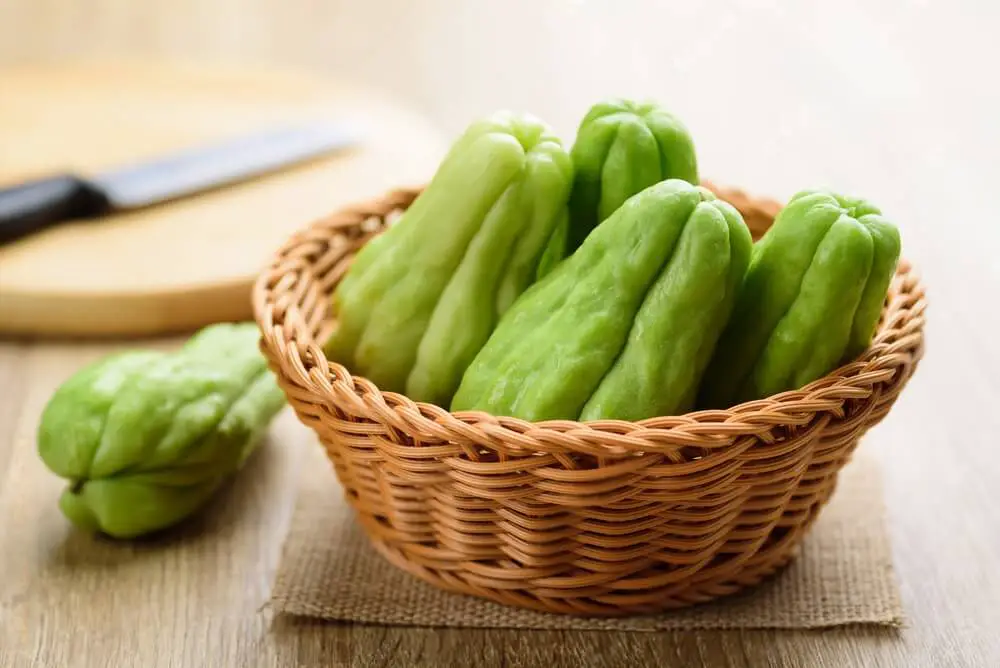Picture this: you’re strolling through a vibrant farmers market, eyes darting from one colorful produce to another, when suddenly your gaze lands upon a peculiar-looking green fruit… or is it a vegetable? Ah, the perplexing chayote! Join us on this delightful journey as we unravel the botanical and culinary enigma surrounding this versatile plant. Brace yourself for a burst of knowledge, a sprinkle of creativity, and a dash of human-like storytelling!
What Is Chayote?
Let’s start by acquainting ourselves with the fascinating chayote plant (Sechium edule), a proud member of the Cucurbitaceae family. Native to Mexico, this crawling vine can grow up to a whopping 10 meters in length. Its pear-shaped fruit, with a slightly wrinkled surface, is the star of our tale. Picture it now: a vibrant green chayote, ripe for the picking, tempting us with its culinary secrets!
What Does Chayote Taste Like?
Close your eyes and imagine the taste of a chayote. Its mild flavor is akin to that of a cool cucumber, refreshing and crisp. Now, let’s dive into its culinary prowess, shall we? Chayote finds its place in savory dishes, inviting us to explore a myriad of cooking techniques. Boil it, bake it, fry it, or toss it raw into a fresh salad; the choice is yours. And let’s not forget about the edible seed that accompanies this delightful fruit!
The Botanical vs. Culinary Conundrum
Ah, the age-old question: is chayote a fruit or a vegetable? Let’s embark on a journey through the realms of botany and culinary arts to find our answer. Botanically speaking, a fruit is a plant part that sprouts from a flower and contains seeds. By this definition, our chayote undoubtedly falls into the fruity category, for it emerges from a blossoming flower and carries a single, flat seed.
However, as we delve into the culinary realm, the lines between fruits and vegetables blur. Typically, fruits are sweet and consumed raw, while vegetables tend to be savory and cooked. Here’s where our chayote showcases its versatility. Though a botanical fruit, it takes center stage in savory culinary creations. Cooked, grilled, sautéed—chayote effortlessly assumes the role of a vegetable, teasing our taste buds with its earthy charm.
Kindred Spirits: Fruits Disguised as Vegetables
Our chayote is not alone in this botanical masquerade. Oh no, dear readers, there are other players in this culinary charade! Take tomatoes, for instance. They proudly display their fruity origins while masquerading as vegetables in savory dishes. Zucchini, bell peppers, and eggplant—oh, the secrets they hold! These botanical fruits gracefully masquerade as vegetables, joining our chayote in the enchanting realm of culinary confusion.
Nutritional Benefits of Chayote
Now that we’ve uncovered the mysteries of chayote’s botanical identity, let’s explore the nutritious gifts it bestows upon us. Low in calories, with a mere 19 per 100-gram serving, chayote proves itself as a guilt-free addition to any diet. Its fibrous nature offers approximately 1.7 grams of fiber per serving, aiding digestion and promoting a healthy gut.
But wait, there’s more! Chayote is a treasure trove of essential vitamins and minerals. Folate takes the stage, supporting healthy fetal development and reducing the risk of birth defects. Vitamins B6 and C join the cast, boosting our immune system and promoting overall well-being. And let’s not forget about potassium, the mineral maestro, regulating blood pressure and keeping our hearts in rhythm.
Culinary Symphony – Chayote Takes Center Stage
With our newfound knowledge of chayote’s identity and its nutritional prowess, let’s explore its culinary repertoire. Prepare to be captivated as chayote dances its way into your taste buds, both raw and cooked. Across Latin American countries, this culinary gem shines in soups, stews, and salads. In Mexico, it dons the mantle of a taco filling, earning its rightful place in the hearts of food enthusiasts. Ah, the revered chiles en nogada, where chayote reveals its true colors as a delectable ingredient.
But hold on, our culinary adventure doesn’t end there! In the Philippines, chayote plays a leading role, frequently partnered with shrimp paste for a harmonious symphony of flavors. And let’s not overlook its sweet side—chayote finds its place in pies and desserts, gracing cakes with its unique charm. In Jamaica, it takes center stage, filling our dessert plates with delight.
Unlocking Health’s Bounty
Beyond its gastronomic marvels, chayote brings forth a plethora of health benefits. Its low-calorie nature, coupled with an abundance of fiber, aids in weight management and keeps us feeling satisfied. Potassium steps in, regulating blood pressure and supporting a healthy heart. The formidable duo of vitamins C and B6 strengthens our immune system and nurtures our brain’s vitality.
But that’s not all—chayote embraces the antioxidant kingdom, protecting our cells from harm and lowering the risk of chronic ailments such as cancer and heart disease. Its high fiber content nurtures our digestive system, promoting regularity and preventing discomfort.
In a Nutshell (or should we say a Chayote Shell?)
As we reach the end of our chayote odyssey, the question of its identity lingers. Is it a fruit or a vegetable? Well, dear readers, the answer lies in the duality of its nature. Botanically, it is undoubtedly a fruit—a proud member of the gourd family, related to pumpkins and cucumbers. Culinary-wise, chayote confidently steps into the role of a vegetable, tantalizing our palates with its savory delights.
Regardless of how we choose to categorize this magnificent plant, one thing remains certain—chayote stands tall as a nutritious and versatile addition to our culinary endeavors. So, the next time you spot a chayote at the farmers market, embrace the mystery, savor its unique flavor, and revel in the joy of nature’s enigma. Is it a fruit? Is it a vegetable? Let it be both—a tantalizing gift from the bountiful gardens of our culinary world.



